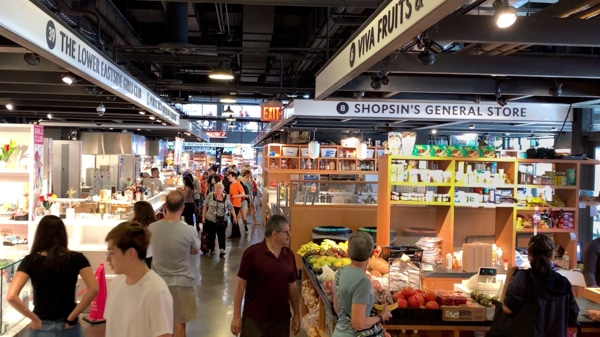
[Updated July 9, 2023] Some sidewalks on the Lower East Side of Manhattan are so narrow I have to step into the street to let oncoming pedestrians pass. Even more so than in other neighborhoods in New York City, there’s an obvious lack of precious space here.
This lack of space always leaves me wondering about Lower East Side history, especially considering it was the most crowded neighborhood in the world at the turn of the 19th century. I can’t help but think about the people who shaped these neighborhoods. What was it like to live here then? How many languages did you hear on the corner of Essex and Delancey?
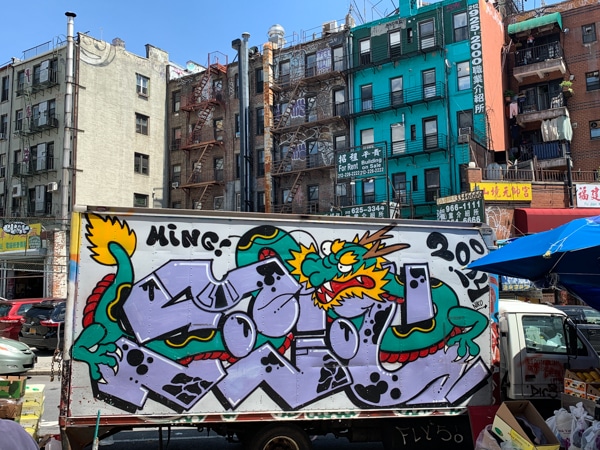
The topic of immigration history in New York City is particularly interesting to me. I wouldn’t be here without it after all, since my relatives arrived at Ellis Island from Italy in 1912. In this article, I put together some of the best ways to learn about the history of immigration in New York City, and how it shaped the city into the multicultural destination it is today.
Because the city was at the root of so much immigration history, the following seven activities are uniquely New York activities.
1. Tour a restored apartment at the Tenement Museum

Several restored apartments tell some of the stories of the 7,000 immigrants that lived in one particular tenement building in the heyday of American immigration. Built in 1863, this tenement was later condemned in the 1930s as a fire hazard. Residents were given little warning and had to leave quickly, abandoning many of their belongings. The building was shuttered for almost 50 years and when it was rediscovered, it was like a time capsule full of stories about people who came in search of a better future.
On guided tours, visitors can see these restored apartments and learn about the real families who lived here. Booking a tour online is easy—the harder part is deciding which tour to take at the Tenement Museum. Matt and I have been on several different tours, because it’s one of our favorite places to take family and friends who come to visit us.
My all-time favorite tour is called Hard Times, where we visit the Baldizzi family apartment and–thanks to stories from the guides–can almost visualize the Italian family sitting around their small kitchen table, playing cards, and perhaps listening to the radio. I also enjoyed the Moore Family tour, which recounted the lives of an Irish family in the 1860s.
Younger people and students love the Confino family tour, during which guests will meet a costumed actor playing a 14-year old girl who immigrated to the United States in 1913.
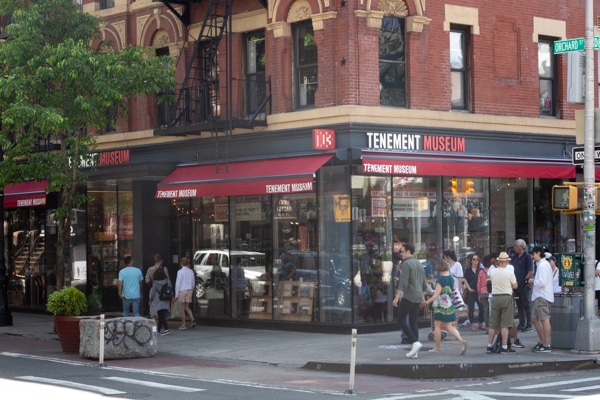
Primary source documents like ship manifests, birth and death certificates, and census records are passed around during the tours to lend authenticity to the stories being told.
Without a doubt, this is one of New York’s coolest attractions. I’ve never had a negative experience. Tour guides are always knowledgeable and do a wonderful job of bringing the tenants to life, with all the joy and hardships they endured.
And life was often difficult. The neighborhood was densely populated. Apartments were stifling in the summer. Living rooms became bedrooms for multiple family members in the evenings. Before running water, tenants ran up and down several flights of stairs per day, fetching water and using the outhouses, which were dismally inadequate to serve the number of residents.
Tenement Museum visitors can also learn even more about the history of immigration by attending one of the museum’s walking tours, special events, and virtual presentations.
- Address: 97 and 103 Orchard St., New York, NY
- Ph: 1-877-975-3786
- The Tenement Museum can only be visited on a guided tour.
- Admission: Adults, Children, Seniors: $30. Members: FREE. Children must be 5+ to attend tours.
- Duration: Tours are typically 60 minutes long.
- Accessibility: See Wheelchair Accessible Tours.
- Subway: F, M, or J to Delancey St. – Essex St. B or D to Grand St.
2. Have a culinary adventure at Essex Market
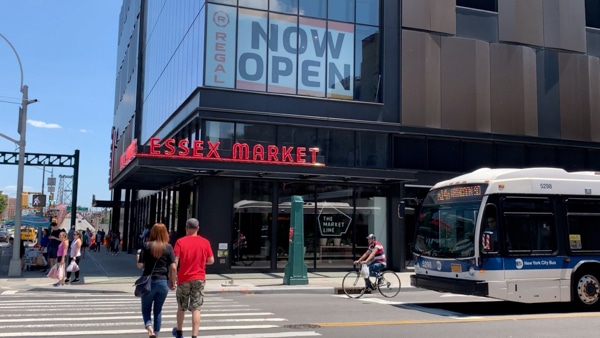
After passing through Ellis Island, immigrants from Hungary, Poland, Greece, Italy, Ukraine, Russia, and Romania settled in tenement buildings on the Lower East Side. By 1910, the neighborhood’s population had soared to five million people. One way to earn a living was to rent a push cart by the day and sell goods that were in demand from fellow countrymen.
Push cart vendors sold everything from baked goods to knishes to hats and shoes, calling out their wares into the congested crowds of shoppers. As the population increased, the area became so crowded with push carts that it created a hygiene crisis and interfered with the safe passage of pedestrians.
Mayor Fiorello LaGuardia, in an effort to ease the congestion crisis, created an indoor public market and moved the push carts inside so that on January 9, 1940, Essex Street Market officially became a New York City indoor public market, consisting of four buildings and 475 vendors.
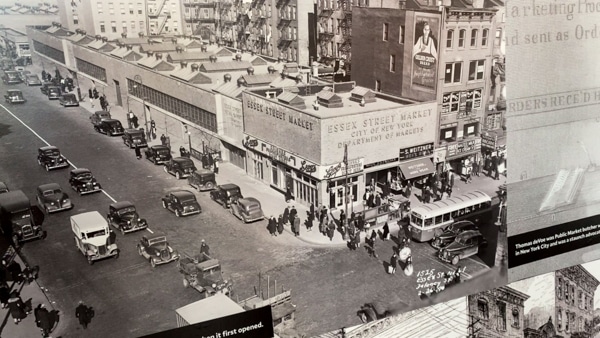
For the next 79 years, vendors sold goods to Lower East Side residents. The market became a social gathering place, and also helped people through the depression by offering advice on how to stretch ration tickets.
In May 2019, Essex Market moved across Delancey Street into a brand-new light-filled, 37,000 square foot building. Most long-time vendors made the move with them and because the space is larger, around 20 new Essex Market vendors were added.
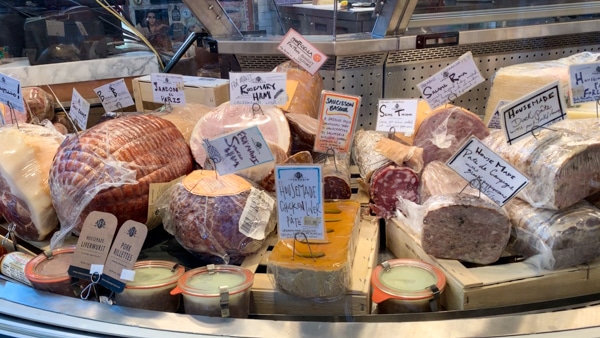
Grocers and fishmongers are there, as are vendors selling Dominican food, Sicilian street food, ceviche, and bagels. There are Japanese snacks, Thai and Mexican food, and a creamery with over 30 types of cheese.
Stroll the aisles with a cup of coffee, gather up an eclectic lunch from various vendors, and park yourself on the second-floor mezzanine, which is a dedicated seating area and a wonderful place to people-watch. Be sure to check out the wall of historical photos at the Delancey Street entrance.
- Address: 88 Essex St. New York, NY
- See business hours.
- Accessibility: A handicap accessible restroom is available on the ground floor. There is an elevator to the mezzanine.
- Subway: F, M, J, or Z to Delancey St. – Essex St.
3. Find solitude at the Museum at Eldridge Street
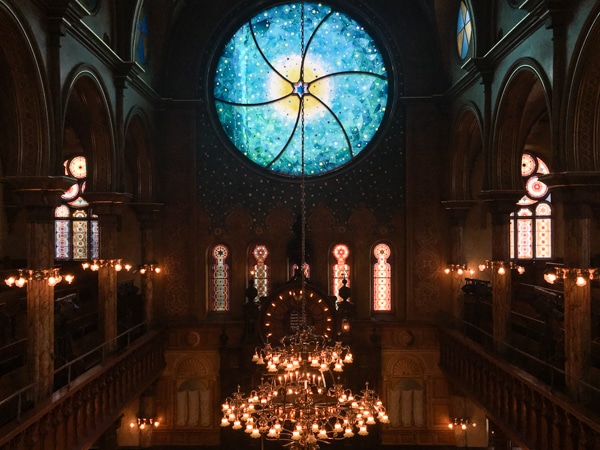
Picture again the cramped, airless apartments of the Tenement Museum and the Lower East Side streets cluttered with push cart peddlers. The Eldridge Street Synagogue was built by and for Jewish immigrants, meant to be a place of light and air and a reprieve from the crowds.
The synagogue, built in 1887, seats more than 750 people. Light streams in from the 67 stained glass windows and an elaborate brass Victorian chandelier hangs from the high ceiling. It was among the first houses of worship built by Eastern European Jewish immigrants, who came to New York in staggering numbers.
Between 1880-1924, the United States received 25 million immigrants. Of those, 2.5 million were Jewish. 85 percent of that number settled in New York City, 75 percent of which lived on the Lower East Side.
The Eldridge Street Synagogue served this dense population. By the early 1920s; however, the Immigrant Quota Laws and movement out of the neighborhood began to have an impact. The number of congregants decreased and eventually the grand main sanctuary was shuttered.

In 1986, a movement to restore the building began. It needed a massive restoration, which cost $20 million and was completed in 2007. The grand sanctuary reopened, and the Museum at Eldridge Street was created.
Below the grand sanctuary are exhibitions, which explain the waves of Jewish immigration to New York. Digital interactive displays allow visitors to hear about prominent congregants, browse photos of the neighborhood through the years, and inspect before and after photos of the renovation project.
The museum hosts classes and events like Egg Rolls, Egg Creams, and Empanadas, a nod to the ever-changing neighborhood they are a part of.
- Address: 12 Eldridge St. New York, NY
- Ph: 212-219-0302
- See business hours and admission
- Self-guided and docent-led tours are available.
- Accessibility: All four levels of the museum are accessible by ramp and elevator.
- Subway: F to East Broadway. B or D to Grand St. 6, N, Q, R, J, or Z to Canal St.
4. Span centuries of history at the Museum of Chinese in America
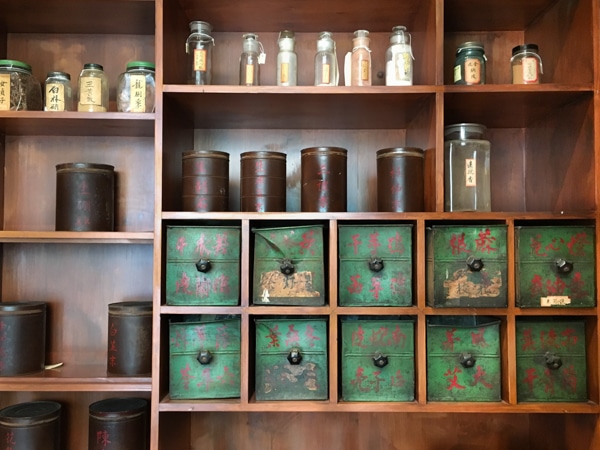
The Museum of Chinese in America (MOCA) is home to more than 160 years of Chinese American history. The Gold Rush brought the first great wave of immigration and by 1865, 50,000 Chinese people were living on the West Coast.
In the 1860s, 10,000 to 20,000 immigrant Chinese laborers worked on the Transcontinental Railroad, working six 12-hour days per week, blasting through mountains, laying trestles, and performing other dangerous, backbreaking tasks. Because the railroad altered the nation completely, it makes sense to say that Chinese immigrants were fundamental in the country’s development.
For many years, their work on the railroad wasn’t recognized, nor was their contribution to the shipbuilding and agricultural industries. MOCA is yet another reminder of everything the country is because of its immigrants.

From their earliest arrival, Chinese immigrants dealt with racism and cruelty, including the widespread belief that they were an “inferior race.” To me, the discrimination felt shocking and familiar at the same time: movie posters advertising films that promoted negative stereotypes, propaganda ads that proposed immigrants were taking jobs away from Americans and finally, the Chinese Exclusion Act of 1882, which blocked immigration to America based solely on race.
The various modes of storytelling is the best part of the MOCA experience. Photographs, letters, and maps cover the walls. A display of wall panels describes little-known or forgotten facts, like how Ah Bing cultivated the Bing Cherry on his farm in Milwaukie, Oregan in 1875, and how Tye Leung was the first Chinese American woman to vote in a U.S. presidential election in 1912. A video appears on a glass panel–it’s about Hazel Lee, the first Chinese American woman to fly in the U.S. military.
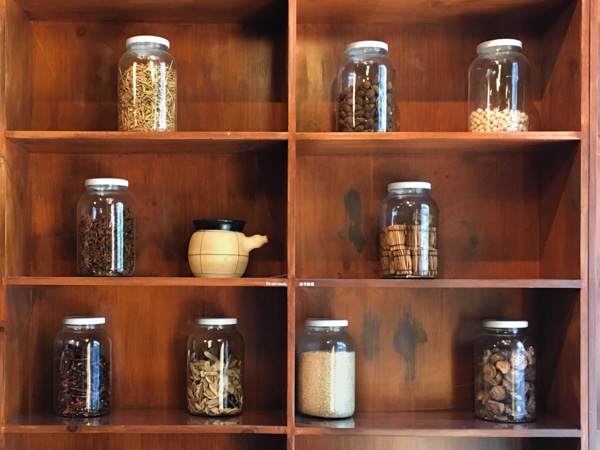
The museum has been in operation since 1980. They existed in a much smaller venue on Mulberry Street until 2009, when Maya Lin created the design for the current building. Lin, who also designed the Vietnam Veterans Memorial in Washington D.C., saw immediate promise in the Chinatown building and said it reminded her of a compound in China where her father grew up.
In a 2009 interview with New York Magazine, Lin said, “it’s not that I’m literally trying to re-create that in the museum but going down those stairs is like seeing where you come from.”
A final reason I love MOCA is because it’s one of New York’s hidden gems and I count it among one of the city’s non-touristy things to do. And if you’re visiting Chinatown in February, be sure to check out the Lunar New Year Parade.
- Address: 215 Centre St. New York, NY
- Ph: 1-855-955-6622
- See business hours and admission
- Accessibility: MOCA is accessible to wheelchair users and others who may not be able to use stairs.
- Subway: B or D to Grand St. 6, N, Q, R, J, or Z to Canal St. A, C, or E to Canal St.
5. Learn about the lives of domestic servants at the Merchant’s House Museum
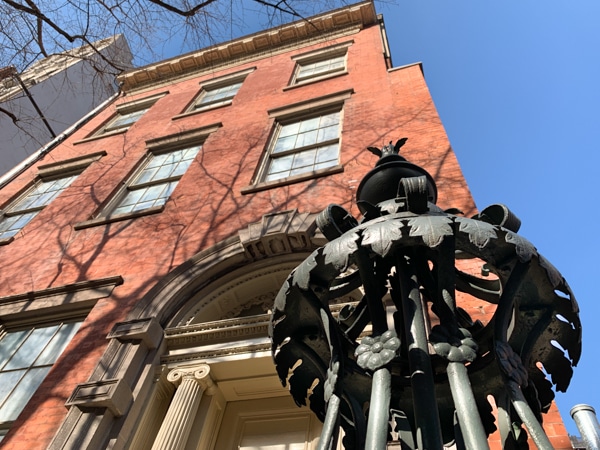
Seabury Tredwell made his fortune in the hardware business. In 1835, he purchased an upscale rowhouse in the quiet, wealthy East Village neighborhood. He retired there with his family and for nearly 100 years, the home was inhabited by a member of the Tredwell family. The last remaining daughter, Gertrude Tredwell, died in an upstairs bedroom in 1933 at the age of 93 (her ghost is said to remain).
The Tredwell family lived full lives, following the complicated social etiquette of the time. They wore fine clothes and hosted social calls, lavish parties, and family dinners.
Behind the scenes, making sure the family lived comfortably and the household ran smoothly were the Tredwell’s servants. Almost always immigrants from Ireland, the servants performed ceaseless, tiring work.
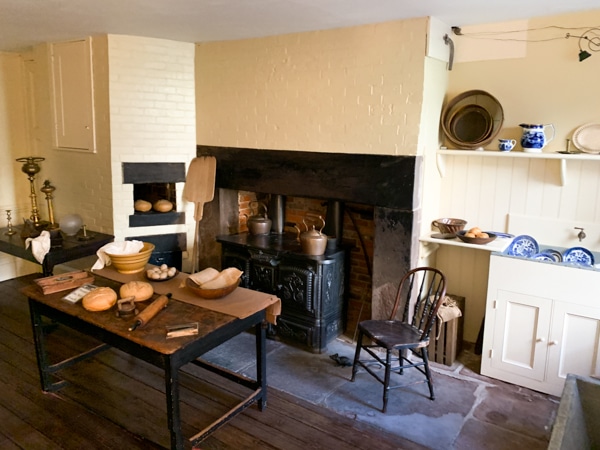
These were the horse and carriage days, so whether you lived in an exclusive neighborhood or not, keeping filth and muck at bay was an ongoing battle. If it wasn’t being dragged into the house by foot, it blew inside with the breeze through old, unsealed windows.
On top of the constant cleaning, cooking, and laundry, the “Irish girls” were responsible for carrying buckets of coal to any room with a coal-burning stove, and buckets of water for baths. Later they collected the ashes and the dirty bath water, carrying them back down the stairs for disposal. They cleaned bedpans and dealt with cockroaches and rodents. (Can you find the (fake) rat in the kitchen photo above?)
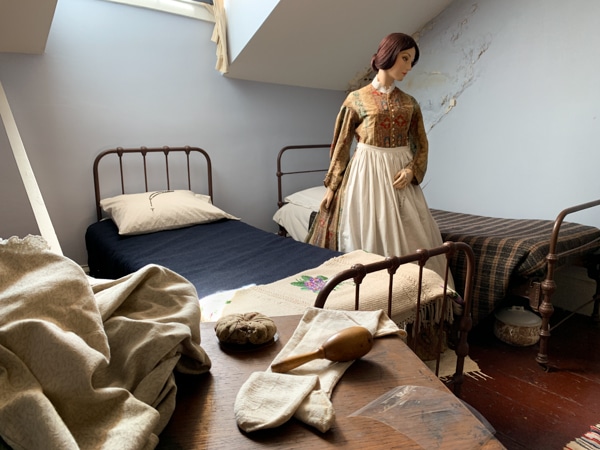
Driven out of their homeland by the Great Famine (1845-1849), Irish immigrants arrived in the United States by the millions and for women and girls, being a domestic servant was preferable to factory work. Domestic workers earned $3-5 per month, enough to send money home and hopefully to pay for another family member’s fare to America.
Probably largely thanks to the care it was given by the Irish servants, the Tredwell home is stunningly well-preserved, with original furniture and fixtures on all three floors. A black horsehair sofa is only barely outdone by large oil portraits which line the walls, and the parlor ceiling is detailed to replicate one found in a Greek temple.
Though Morris-Jumel Mansion was built long before the Tredwell home, the latter is considered to be the oldest continually lived in residence in Manhattan, and certainly the best preserved.
- Address: 29 East Fourth St., New York, NY
- Ph: 212-777-1089
- See hours and admission
- Self-guided and docent-led tours are available.
- Accessibility: Merchant’s House Museum is not wheelchair accessible.
- Subway: N or R to 8th St. 6 to Astor Place. B, D, F, or M to Broadway/Lafayette.
6. Clock some miles on the Culture Clash Running Tour
In general, I like to exercise outdoors and one thing I love about my Inwood neighborhood are the parks where I can run, walk, and hike. But something I’ve always loved about traveling is going for long runs in tourist hot spots.
Doing a normal activity in an extraordinary setting changes the experience entirely. When I lived in Istanbul, I ran from Asia to Europe in the 10K leg of the Istanbul Half Marathon. In Cambodia, ancient religious monuments kept me company during the Angkor Wat Half Marathon. Both experiences brought me more personal, less crowded interactions and I started looking for similar experiences wherever I traveled.

A couple of years ago on a trip to Belgium, I did a “sight-running” tour in Bruges. As tours go, I felt much more like an active participant and less like a weary tourist straggling behind my guide.
I immediately looked for a similar experience in New York. When I found City Running Tours, I was thrilled they offered several themed tours. I naturally chose Culture Clash, the one related to immigration history, since my interest in that area runs deep.
On the particular summer day I had booked, there was only me and another runner, and our guide Sarah. We met on a corner in SoHo (I had received an email the day before with a specific meeting place) and Sarah explained a little about what we could expect and said she’d set her running pace to ours.
The next hour and a half consisted of a jogging tour on the streets of Chinatown, Little Italy, and the Lower East Side. In Chinatown we stopped on Doyers Street. Sarah described its early 20th century history, when it was known for gang violence and nicknamed the “Bloody Angle.” The 200-yard-long street was actually stained red from bloodshed. Later it became known for its garment shops, which financially sustained generations of Chinese immigrants.
On we ran to Little Italy, where Sarah described the history of Italian migration, then to the Lower East Side for a discussion of the millions of immigrants who had walked those streets.
The tour was a lot of fun. It was informal and conversational and Sarah knew her history. The Culture Clash tour runs on Thursdays at 8:00 a.m., which means we witnessed the city waking up as we ran on the narrow streets of Lower Manhattan.
This tour will give you a basic overview of historical immigration sites in NYC. It is the perfect option if you’re running short on time and you want to fit in a morning run.
- Duration and distance: 1.5 hours. 4.5 miles (7.2k).
- Cost: $40
- Meeting place: 610 Broadway at Houston (Entrance to Adidas store)
- Schedule: 8 a.m. every Thursday
- Subway: B, D, F, or M to Broadway/Lafayette. R or W to Prince St. 6 to Bleecker St.
7. Eat at historic restaurants in Chinatown and the Lower East Side
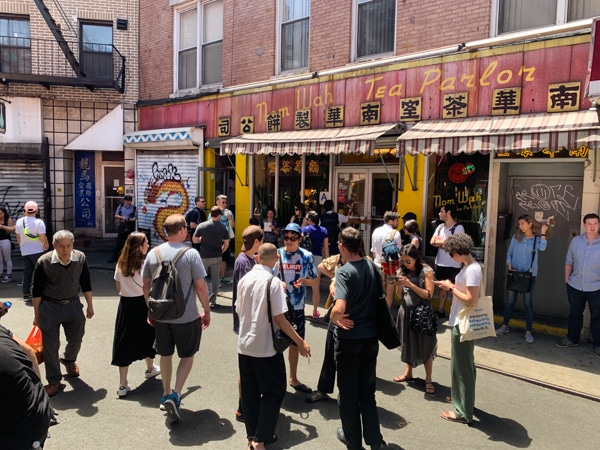
Top off your tour of immigration history with one of the diverse restaurants in the area. Nom Wah Tea Parlor is New York’s oldest Dim Sum restaurant. Katz’s Deli has been serving incomparable pastrami sandwiches since 1888. Russ & Daughters sells some of the best lox and bagels in New York City.
Final Thoughts on the History of Immigration in New York City
Visitors to New York City often want to see the city’s soaring skyscrapers, scenic parks like the High Line, and shiny new neighborhoods like Hudson Yards. But so much of America’s history happened here and it’s always fascinating to learn about people’s lives throughout the centuries. In the case of immigration history, visiting places where people lived, ate, and worshipped is especially meaningful.